Accommodating The Psoas When Sleeping
The picture to the left is my son Reggie.
His sleep position mirrors how I slept for the first forty years of my life.
One knee hiked up, basically sleeping on the stomach which is just awful for the spine but easy for the psoas muscle.
Technically this isn’t full-on stomach sleeping which is even worse but really, who wants to win a misery contest?
Sleeping on the stomach flattens the curve of the lumbar spine from which no good can come.
Sleeping with one knee raised over the other creates a torque in the pelvis for the duration of sleep.
Again no good can come from a pelvis that is misaligned for hours at a time.
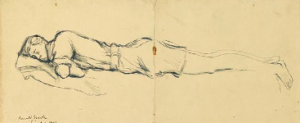
Why we do this is another story. I have always felt that the body finds itself in this position as a means of accommodating a tight psoas.
If your psoas muscle is tight it will be much more comfortable with the leg and hip flexed.
For years I woke up with a stiff and achy back. When I finally committed to sleeping on my side with my legs together and slightly bent, it didn’t take long for a lot of my nightly discomfort to pass.
For my clients, I recommend sleeping with a pillow between the legs and tieing a belt around the thighs.
It’s best if it’s a bathrobe sash, or something equally soft, that is less likely to wake you up once you have fallen asleep.
Personally, I didn’t need to tie my legs together to stop them from separating but I have had plenty of clients who had to go that far in order to change a lifelong habit.
The Psoas Major Muscle
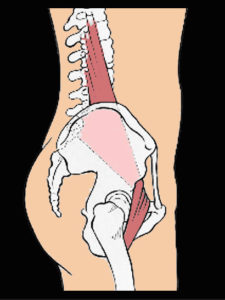 .
. 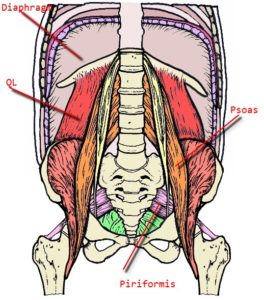 .
. 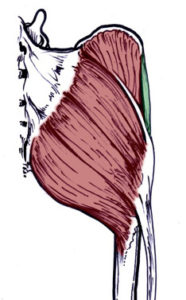
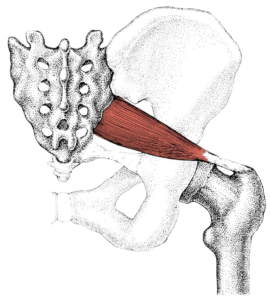
The psoas major is one of only three muscles in the body that connect the legs to the spine making it a very important muscle.
Gluteus maximus and piriformis are the other two muscles that connect the legs to the spine.
They connect at the back of the body and the psoas major connects at the front.
Standing and walking are both directly influenced by the psoas which I consider the most important muscle in the body.
There is no doubt that the heart and tongue are also super important but the psoas outranks them in my book.
Pain and trauma are also directly impacted by this extraordinary muscle. It is the body’s main hip flexor muscle and as a result, it responds to any fear or danger.
Other, more minor, hip flexors include the iliacus, pectineus, and sartorius ( and a couple of others),
Flexion is always a part of our fight or flight response (fear is flexion) so any time we are in danger the hip flexors fire.
If we feel that we are always in danger these muscles fire and stay fired, or on alert, to fire at a moment’s notice.
This can have a profound effect on our nervous system and from my perspective is often why people find themselves in chronic pain that they can’t figure out, or heal.
Our nervous system can stop working well when negative things arise consistently– such as living in an emotionally violent home, a bad neighborhood, or a war zone.
Singular events like a car accident, witnessing a violent act, or being the victim of a crime can also have a terrible effect on our nervous system.
And it is my belief that energy from these events that we can’t process in the moment gets stored in the psoas to be released when we are capable of letting it go.
 The Pull Of A Tight Psoas
The Pull Of A Tight Psoas
The classic pull of a tight psoas pulls the leg into the hip socket and turns out the same foot. In the trunk, the pelvis is hiked up and the shoulder of the same side is pulled down toward the hip.
The whole affected side shortens.
The thing is that I don’t think Reggie has a particularly tight psoas so I am not exactly sure why he gravitates towards this position.
Unless the pattern was in my DNA that I shared with him because he has never seen me sleep this way (my daughter never sleeps in this position).
So many people carry around aches and pains that are relatively easy to resolve but require a conscious approach to things we don’t think about.
Most people do not think for a second consider that their sleep position could be harmful.
And then there are those who have a sense that the way that they sleep could be a problem due to how they feel when they wake up. But that doesn’t mean they can make the leap to change.
There are injuries that we suffer as a direct result of an action—a car accident, a fall down stairs—but there are also repetitive stress injuries that add up over years of poor patterning.
Stop hiking your knee up— and accommodating your tight psoas— and see if your sleep and pain issues improve.
Changing your sleep routine is just one piece in a big pain relief puzzle but it is essential.

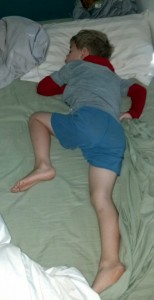
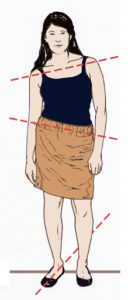 The Pull Of A Tight Psoas
The Pull Of A Tight Psoas